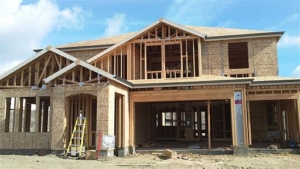
A home in Dublin, California, USA under construction. By Rishichhibber (Own work) CC BY-SA 3.0, via Wikimedia Commons
Not since 2007 have existing home sales reached this high of an annual rate. Last month total existing home sales jumped to a seasonally-adjusted annual rate of 5.53 million, the highest since February 2007’s rate of 5.79 million. Sales are 4.5 percent higher than a year ago at this time, continuing what has been a strong year for home sales. Existing home sales include single-family homes, townhomes, condominiums, as well as co-ops.
The total housing supply is 5.7 percent lower than a year ago when 2.28 million homes were on the market, compared to 2.15 million homes last month. The good news is that the supply bottleneck is improving. May’s inventory was 1.4 percent lower than April 2016.
New home sales also did well in May, at an adjusted annual rate of 551,000. That’s down a bit from April’s 586,000. However, May was ahead of 2016’s pace established over the first three months (average of 524,000 home sales per month). New home sales continue to climb now that the housing market crash and resulting economic downturn are in the rearview mirror.
Builders are also enthusiastic with the current housing market. The latest builder confidence survey reached 60, a level that hasn’t been seen since January. A score above 50 on the Housing Market Index (HMI) indicates builders believe the market is in good shape.
“Builders in many markets across the nation are reporting higher traffic and more committed buyers at their job sites,” said NAHB Chairman Ed Brady.
The fast pace of home sales also pushed higher the median price of an existing home, thanks in part to the ongoing issue of a tight supply. Home prices are rising for homes generally, but entry-level homes are seeing the biggest percentage increases. Home values for entry-level homes increased eight percent over the past year. More expensive homes, however, had values increase at half that rate.
One reason for this differential is that entry-level homes are in higher demand, but there are fewer of them available. On the other hand, expensive homes have, in relative terms, been in a constant supply for buyers. Only 24.6 percent of the homes for sale in May were entry-level homes. However, 47.5 percent of the homes on the market were top-tier, or more expensive, homes. As a result, buyers for entry-level homes are willing to pay over the advertised price.
All the data points to the summer buying season being in full swing. How do you feel the housing market will fare this summer? Let us know in the comments.





Recent Comments